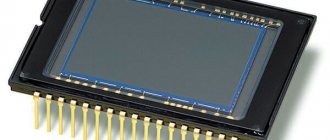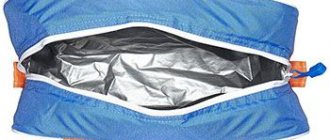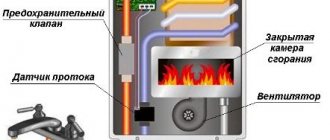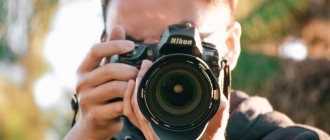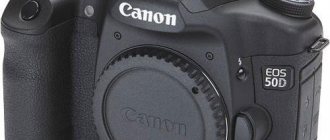Today, no one will be surprised by a new SLR camera in the hands of an inexperienced student. It has become very prestigious to have a DSLR instead of a regular digital camera. Naturally, most often in the selection process no one cares about the main parameters of the camera, the main thing is the price tag and the word SLR. Although when the need arises to purchase not for status, but for maximum functionality. The question arises: “how to choose a SLR camera?”
There are many resources on the Internet with specialized information for professional photographers, which the average user cannot understand. Therefore, the article contains all the important concepts for beginners and explains them in simple language. Well, for greater usefulness, a review of the best camera models in the category.
What is a SLR camera
To clarify, you can look into any electronic encyclopedia and find an incomprehensible set of words instead of a definition.
Translated into Russian, a DSLR can be called any representative of this segment of technology that has a mirror in its device.
Using a lens system, light penetrates the body of the camera, is reflected from the mirror prism and hits the matrix, which transmits the image to the viewfinder.
Here another unfamiliar word appears: matrix. In essence, the matrix is a semiconductor wafer on which there are ultra-sensitive cells - pixels. They take photos by capturing light waves and converting them into electromagnetic waves.
In ordinary cameras there is no mirror, as well as a lens system, that is, the light falls directly on a specially modified matrix. Naturally, when electronics are used, the image is delayed and distorted.
SLR cameras are divided into amateur and professional.
Battle of the Century – Nikon and Kenon
Every photographer who owns a digital camera is proud of its brand. Get ready to take part in a competition between two of the most popular brands in the world of digital photography – Nikon and Canon. It is the cameras of these manufacturers that occupy the main niche of the best “DSLRs” on the market.
Besides them, there are other companies - Pentax, Sony, Olympys, Fujifilm, Panasonic. But DSLR cameras are not their main product line. It is better to give preference to those manufacturers who are completely devoted to the production and implementation of new technologies.
Owning an SLR camera from a well-known company will additionally save you from the shortage of components and accessories, because in this case they are literally always available for sale.
Pros of a DSLR camera
If you ask a professional photographer about the advantages of a DSLR camera, he will begin to list countless specific characteristics of the camera.
The main advantages are: long battery life without recharging, fast operating speed, clarity of images, natural (without distortion) colors, excellent performance in any lighting.
All of the above advantages are determined by the design features of the camera and depend on the performance of the filling.
Camera battery life
How to choose the right camera with a good battery? Here you need to be sure to look at the operating time with the display turned on; manufacturers like to write the battery operating time without load, but the display, lens focusing, flash and other parameters consume power very quickly. It is important to take into account all these parameters and not fall for the tricks of the manufacturer and seller. For long trips, we recommend that you buy a removable battery that will last you for a long time.
accumulator battery
How to choose the right DSLR cameras
The question is interesting, to answer it you need to find out something else: what characteristics are worth paying attention to.
The first thing you need to decide is whether the lens is important to you in the photography process or whether you can get by with the camera itself.
Glass (lens) can be different. Prices also vary. At the beginning of mastering professional photography, it is recommended to limit yourself to a basic lens or kit, as it is also called. Maybe all the delights of the camera will seem unnecessary to you and further advancement is useless. Then additional expenses can also be eliminated.
When purchasing an accessory, a beginner should look at the focal length of the mirror. 18-55 is considered optimal. It will help you photograph both distant and close objects without any problems.
Another tip: if you really want to make your life easier, then buy a DSLR without glass. And after mastering the basic principles, you will already select the appropriate equipment.
The next important parameter in a DSLR camera is the matrix. At its core, it is considered an analogue of a frame on film and is responsible for the quality of the image.
When choosing a camera, the size and resolution of the matrix are important. The optimal resolution is 10-12 megapixels. No more manufacturers needing to say nothing. But it is better to choose a larger size. The larger the area, the more beautiful the pictures will be.
In addition, you need to take into account the ISO level (sensitivity) of the matrix, that is, the level of light perception. A higher rate will make it possible to shoot in poorly lit rooms and outdoors at night.
Currently, two types of matrices are used: CDD (charge-coupled device) and CMOS (complementary metal-oxide-conductor).
The first ones are taken for quality: the level of “noise” is very low. The latter benefit in price, although the quality suffers from this: there is a lot of interference. But they think quickly and consume less battery.
Another gobbledygook in the description of the DSLR can be the speed and stabilization.
For the DSLR brother of the digital camera, stabilization helps eliminate blurry shooting, even when the photographer’s hands are shaking. The only disadvantage of such a system is that the photo is not very sharp. A similar characteristic can be found in both the camera and the lens. It will be terribly useful for beginners.
Its superior speed gives the DSLR the ability to capture action shots, whether it's a pet or a competition.
Based on the above characteristics, you can choose the one that is most convenient for you.
Of course, all this is just a theory that needs to be applied in practice, that is, in comparing real cameras. The only thing that still needs to be remembered is the desire parameters. For example, the maximum resolution in all flagship models is much higher than optimal. The reason is simple, marketing: 40 megapixels sounds better than 12.
Which set is better to choose, body or kit?
How to choose the right camera and not spend extra money? You can save on choosing components. Body is a SLR camera without a lens (body), this choice is for a professional who already knows what he needs from such equipment. Kit is a DSLR camera with a standard universal lens, usually not the best image quality, but such lenses solve many problems for beginners for minimal money.
The travel-picture.ru team advises not to rack your brains when choosing a camera; if you are planning to shoot ordinary tourist landscapes or family holidays, then KIT is for you. If you want to get into artistic photography, then you definitely need to be very responsible when choosing a lens. But we already talked about which lens to choose in the previous article in our “everything about travel photography” section. Looking ahead, let's say one thing: good optics cost much more than a camera and the development of the world of electronics does not in any way affect the quality of shooting, no matter what the sellers tell you, optics decide everything here!
Rating of the best SLR cameras
Our experts have compiled a list of the best SLR cameras, the list of the best is presented below:
- Nikkon D5300;
- Canon EOS 600D;
- Sony Alpha ILCA-A77 II;
- Nikon D3200;
- Canon EOS 70D.
Below we briefly describe each model.
Mirror camera Nikon D5300 kit 18-55
Despite being budget-friendly, the camera's parameters are impressive. A focal length of 18-55 will help you play with zooming in and out without any problems. DSLR stabilizer will add clarity. Speed 5 fps. in the first couple of minutes it will not allow you to miss the most interesting moments. And the ability to connect to wi-fi simplifies the process of moving work results. According to professionals, the model is the best in its category.
Canon EOS 600D Kit 18-135
Owners claim excellent photographs obtained as a result of use. Matrix: 18 megapixels, focal length: 18-135, shooting frequency 3.7 frames per second - all this will be useful to fans of miniature photography. In addition, the device is considered an analogue of the Nikon D5300 kit 18-55 only from Cannon.
Sony Alpha ILCA-A77 II Kit 18-135
This model is more suitable for experienced users, as it has a rather large set of specific functions: with a focal length like the previous analogue, this device can offer 79 different positions in zoom mode, as well as a shooting speed of up to 12 frames per second.
Nikon D3200
Another camera for beginners can please buyers not only with its simple interface, but also with an affordable price. 24 megapixel expansion, 11 zoom points, the ability to take 4 pictures per second. The choice of mirror model for a novice amateur is obvious.
Canon EOS 70D
The Japanese assembly clearly adds credibility to this DSLR. For connoisseurs of movement, there is a sport mode here. A 20.2 megapixel matrix and 19 focusing points provide almost unlimited shooting possibilities.
Finally, I would like to say that no matter what camera you choose, a SLR or a simple one, the main thing in the process is to focus only on yourself. It’s better to buy something simpler, but functional and comfortable. No matter how cool the camera is, without the necessary controls the photos will not be of the highest quality.
Let's determine the cost and goals
The first thing you need to do is decide on a budget. Camera prices vary significantly. Therefore, depending on the money you have, you will need to select a model.
Buy inexpensive DSLRs for amateur photography. A novice photographer will immediately notice the difference in the quality of the frames compared to a regular point-and-shoot camera.
For beginners and future professionals in the field of wedding and studio photography (if you want to become one), you need to consider models of SLR cameras at an average or high price. They offer great options for creativity.
Advice. When choosing a model, pay attention to the year of manufacture. The more recent it is, the less problems you will have with firmware updates and purchasing camera accessories.
ISO sensitivity
ISO sensitivity measures how sensitive the sensor is to incoming light. The darker the scene, the higher the ISO required for photography. Bright scenes are captured at low ISO. DSLR cameras have significantly higher ISO ratings than compact cameras. A wider ISO range allows you to shoot in a wide range of lighting conditions.
There is a simple rule for ISO settings: you should aim to use the lowest ISO possible. The fact is that when shooting at high ISO values, graininess often appears in photographs. There is less grain when shooting with DSLR cameras because their sensor is larger than that of compact cameras. In addition, DSLR cameras allow you to set the required ISO parameter manually. If you are a beginner photographer, it is better to set the ISO parameter to Auto mode.
CPU
Typically, the electronics of SLR cameras are better than those of point-and-shoot cameras. And the processor, which is the brain of your camera, is no exception. Comparing processors from different manufacturers is quite difficult, due to the fact that the characteristics of processors are not published. In addition, the processor cannot work without software, which is also closed and specific to each brand. Camera programs allow you to process images and have many settings.
Processors can be compared by how different cameras handle processor-dependent operations. For example, how quickly a camera can shoot a series of photos, or how quickly a high-resolution photo can be written to a memory card. The electronics of SLR cameras are much more powerful than the equipment of compact cameras.
Automatic multi-point focusing
Almost all modern cameras are equipped with an automatic focusing system. Many allow you to select a shooting mode: portrait, landscape, macro photography and others. The multi-point autofocus system is more advanced and has the following advantages:
- it allows you to keep focus on a moving subject, which is very useful when capturing movement or shooting video
- the system can select the focus mode itself and set the correct exposure
- The system recognizes people's faces and automatically adjusts for the best portrait shooting
- Many DSLRs with multi-point autofocus will focus and adjust exposure on the fly, automatically selecting the desired settings. All the photographer has to do is press a button.
DSLR cameras can have a lot of other useful features and capabilities, including HDR mode, 4K video shooting, Wi-Fi connectivity and others. Before purchasing a specific model, we recommend reading reviews on the Internet and watching video reviews.
Matrix check
Well, here is the main parameter that you definitely need to pay attention to – dead pixels. Dead pixels are a defect of the matrix and in the photograph they are visible in the form of black or white dots in the same place in the photograph.
In order to determine the used pixels, you should take a series of pictures to warm up the matrix and photograph a black and white background, then look at the resulting pictures on a computer.
There should be no white dots on a black background and vice versa with a white background. Stores have special computer programs to detect matrix defects; the main thing is to mention this point in our article to the seller.
dead pixels on a black background
dead pixels on a white background
Now let's talk about mirrorless cameras...
Sensor: APS-C or full frame sensor
The sensor is a chip that converts the image projected onto it through the lens into electrical signals. A very simple rule works in digital photography: the larger the sensor, the better. A larger sensor can collect more light and therefore more information about the image. You can buy a camera with an APS-C sensor or a full frame sensor (35 mm). The APS-C sensor size is 54% of the full frame sensor size. The sensor of SLR cameras is much larger than the sensors of smartphones and point-and-shoot cameras. The APS-C sensor allows you to get very high-quality photos that will be significantly better than photos taken with a point-and-shoot camera. Professional photographers prefer devices with a full frame sensor. It should be noted that these are very expensive cameras.
